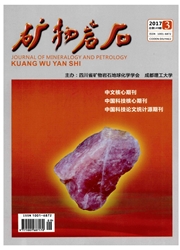

 中文摘要:
中文摘要:
西南“三江”大勐龙岩群一直被认为是元古宙的基底岩石,但迄今无可靠的年代学数据约束。针对昌宁-孟连构造带牛井山地区大勐龙岩群云母石英片岩进行碎屑锆石U-Pb定年,为其增添年代学证据。锆石阴极发光(CL)图像显示碎屑锆石有明显的生长振荡环带,指示它们为岩浆成因。D0003-4样品81颗碎屑锆石年龄谐和度高,分布在342Ma-2 928 Ma的宽广范围,形成多个群组,最年轻一组加权平均年龄为349 Ma±3 Ma(MSWD=1.1,n=8)。碎屑锆石U-Pb年代学特征表明,牛井山地区原定“大勐龙岩群”最大沉积时限不早于349 Ma±3 Ma。野外地质特征和年代学数据共同表明牛井山地区大勐龙岩群很可能是由泥盆-石炭系南段组(349 Ma±3 Ma)或更年轻的二叠系拉巴组受后期变质形成。根据已有可靠同位素数据与综合分析,认为三江地区现今所定义的大勐龙岩群是不同时代、不同岩性的地层/岩体经后期变质作用形成的变质杂岩,不全是古老基底岩石出露。
 英文摘要:
英文摘要:
This paper focus on the LA-ICP-MS U-Pb ages of the detrital zircons from mica quartz schist of the Damenglong Group in the Niujingshan area of Changning-Menglian tectonic belt. Cathodoluminescence(CL)imaging reveals that these zircon crystals generally have oscillatory zoning,implying their magmatic genesis. Eighty-one analyses of D0003-4 yield concordant ages ranging from 342 Ma to 2 928 Ma,with the youngest age group of 349 Ma±3 Ma(MSWD= 1.1 ,n=8). It is showed that the maximum depositional age of the Damenglong Group in the Niujinshan area is less than 349 Ma±3 Ma and 357 Ma±7 Ma. Geological characteristics and reliable isotopic ages indicate that the Damengtong Group rocks in Niujinshan essentially are low-grade metamorphic clastic sedimentary rocks of the Nanduan Formation (D-C) or Laba Formation (P). According to available isotope age data and comprehensive analysis,it is considered that the socalled Damenglong Group in the Nujiang-Lancangjiang-Jinshajiang area are complicated metamorphic complex composed of various parent components with different ages, rather than entirely Proterozoic crystalline basement rocks as previously considered.
 同期刊论文项目
同期刊论文项目
 同项目期刊论文
同项目期刊论文
 期刊信息
期刊信息
